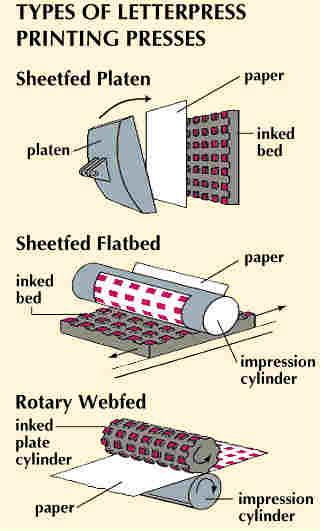
- •Lesson 1
- •Preparation for Printing
- •Vocabulary notes:
- •Lesson 2
- •Letterpress.
- •Vocabulary notes.
- •Lesson 3
- •Intaglio.
- •Vocabulary notes:
- •Lesson 4
- •Vocabulary notes:
- •Lesson 5
- •History
- •Vocabulary notes:
- •Lesson 6
- •Industry organization
- •Vocabulary notes:
- •Part II
- •Industry organization
- •Vocabulary notes:
- •Lesson 7
- •Resent developments
- •Vocabulary notes:
- •Lesson 8
- •Occupations in the industry
- •Vocabulary notes:
Lesson 2
Exercise 1. Read and translate the text.
Letterpress.

Letterpress, or relief, printing is one of the oldest processes. The type is raised from the background plate so that when the type is inked and pressed against paper, only the raised portions transmit the image to the paper's surface. Originally type was cast piece by piece in small, hand-held casters. By the 19th century, type could be cast and set into text in a single operation, either by Monotype machines, which set single characters, or Linotype machines, which set entire lines in a single slug. The soft metal casts tended to wear down quickly in the printing process, however, and had to be replaced with fresh type.
To solve this problem, a means of making more durable plates was invented. Two of the most common methods are electrotyping and stereotyping. Electrotyping uses an electroplating process to create printing plates. Type is set and a cast made, usually out of wax, which is then coated in graphite and placed in an electroplating bath. A copper shell, or casting, is built up in the shape of the original type. When backed with metal, it makes a durable letterpress plate for high-volume printing. Stereotyping begins by making a mould of set type using a heat-resistant papier-mâché. Molten metal is then poured into the mould to create the cast plate. In more recent years, lighter and less expensive plates of rubber and plastic have been developed.
Letterpress printing uses three designs of printing press: sheet fed platen, sheet fed flatbed, and rotary presses, which can be sheet fed or web fed. In sheet fed presses, individual sheets of paper are fed into the press. In web fed presses, a continuous roll of paper is fed through the press.
Platen presses are the oldest type and are used for small printing jobs. They consist of a flat bed on which the images (type or plates) are laid and another flat surface, the platen, which is connected to a screw or lever. Paper is laid on the bed and pressed by the platen to transfer the image to the surface. Printing on early presses was a slow process, since the paper had to be fed one sheet at a time into the press. Improvements made in the 1830s and 1840s featured automatic inking and mechanical power, which increased printing speed from a few dozen sheets an hour to more than a thousand.
Sheet fed flatbed presses feature a cylinder, on which the paper is attached, that rolls over the bed of inked type. This design overcame the problem of uneven impression on the paper surface that often occurred in platen presses.
In rotary web fed presses a continuous roll of paper is fed between two cylinders, the plate cylinder and the impression cylinder. The plate cylinder, either electrotype or stereotype, is automatically inked and pressed against the paper as it unrolls. After the paper is printed, it can be cut into individual sheets and folded. Flatbed and rotary presses can be designed to print on both sides of the paper simultaneously and to reproduce colour illustrations. These machines were responsible for the enormous growth of newspapers during the 19th century.
